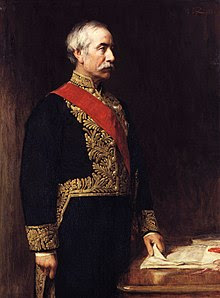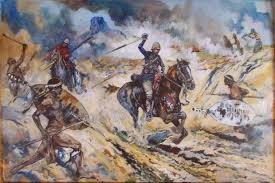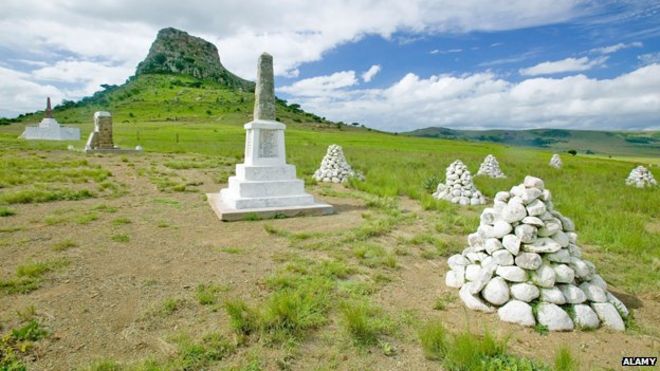
The Battle of Isandlwana by Charles Edwin Fripp
The war between Great Britain and the Zulu Empire, a scheme concocted by Sir Henry Bartle Frere to gain the English more African lands, begins on the morning of 1/11 with a three-pronged invasion of King Cetshwayo's territory by 15,000 soldiers and their supports under the command of General Frederic Augustus Thesiger, the 2nd Baron Chelmsford, a veteran of actions in the Crimean War and the Indian Mutiny of 1857.

Frere

Lord Chelmsford

Cetshwayo
The debacle for British arms begins with several miscalculations. The invasion of Zululand takes place at the beginning of the harvest season when it is believed the native forces will be scattered, but have actually gathered at the capital village of Ulundi to participate in the annual First Fruits ceremony (Cetshwayo sends his warriors off with the command, "March slowly, attack at dawn and eat up the red soldiers!") ... and January is a rainy season in South Africa, wet from the sky that severely hampers Chelmsford's advance. Most importantly though, the British go into the war with a mindset that no Zulu warrior, armed with only an assegai stabbing spear, a knobkierre club, and a cowhide shield can best an English soldier. They are in for a rude awakening!

Readying to Rumble
Reaching Isandlwana, Chelmsford shows his disdain for the fighting abilities of the Zulus ... standard orders for entrenching and circling the wagons are ignored, and with no information as to the whereabouts of the Zulu (he is totally unaware that over 20,000 warriors are now behind him and intend to attack at dawn of the 23rd), he splits his force, advancing in the direction of Ulundi with over 2,000 soldiers, while leaving another 2,000 or so men to man his base camp. Grave errors, the mistakes are further acerbated by leaving the base in the command of a man who has never been in combat, Brevet Lt. Colonel Henry Burmester Pulleine. Additionally, there will be leadership issues of who is in charge when Lt. Colonel Anthony William Durnford arrives at Isandlwana with a contingent of Natal cavalry and a rocket battery ... a member of the Royal Engineers, Durnford outranks Pulleine!
Pulleine

Durnford
Pieces in place for the upcoming tragedy, the Battle of Isandlwana begins at around 11:00 in the morning, when a British patrol chasing a small group warriors, stumbles on to the valley hiding place (featuring tall grasses and many ravines, the area around Isandlwana is excellent for concealment) the terrain of the main Zulu army under the command of inDunas (Princes) Ntshingwayo kaMahole Khoza and Mavumengwana kaNdlela Ntuli. Shifting plans on the fly, the Zulu army instantly abandons its plans for an attack the next day and instead rushes forward at the camp ... using their standard battle plan of having their forces configured in the form of a buffalo ... left and right horns, and a larger grouping as the chest, with envelopment and total destruction of the enemy the goal.

Yikes!
Spears and clubs against horses, revolvers, Martini-Henry rifles, artillery shells and rockets, for over an hour the British hold back charge after charge of the Zulus, but things begin to fall apart when Dunford's group of soldiers, keeping the left horn in check, run out of ammunition (fighting too far forward, the bullets he needs come out of their sealed containers too slowly to be of help) and are forced to retreat into the camp ... and the dominoes begin to fall.

Last Stand of Dunford
Flanked and then enveloped, the clash soon breaks down into a series of desperate last stands ... ammunition gone, the British stand back-to-back and fight their attackers with bayonets, rifle butts, and bare knuckles. It is not enough against thousands of angry warriors. And during this bloody nightmare, a solar eclipse for a few minutes places the camp in darkness. It is all over by about 4:00 in the afternoon.



Last Stand
Along with over a thousand slaughtered soldiers (casualties for the Zulus are unknown, but is believed they lose roughly 1,000 warriors in the battle), the British lose 1,000 rifles, two field guns, 400,000 rounds of ammunition, 2,000 draft animals, 130 wagons, and an army's worth of supplies that include canned goods, biscuits, beer, uniforms, hundreds of tents, and three color flags. And it is the loss of one of those flags that eventually results in the eventual posthumous awarding of the Victoria Cross to 25-year-old Lt. Nevill Josiah Aylmer Coghill and 36-year-old Lt. Teignmouth Melvill.

Melvill

Coghill
Ordered by Pulleine to save the Queen's Color of the 24th Regiment of Foot, the two men make a wild ride through the camp (with Melvill carrying the flag), closely pursued dozens of Zulus, but are stopped trying to cross the swollen Buffalo River at a "shallow" area that will come to be called Fugitives' Drift. When Melvill loses his horse in the river, Coghill goes to his rescue (riding back though he had reached the far bank of the river's safety) ... and the two put up yet another of the day's valiant, but doomed last stands. Not entirely in vain though. Somewhere in the melee that takes place at the river, the flag is swept away and floats down the river ... where it is found 10 days later, 500 yards downstream.
Saving the Colors

Escape

Death Ride
Escape

Death Ride
At the Buffalo River

Last Sleep of the Brave, 1879
by Alphonse de Neuville
Later returned to Great Britain in the care of an honor guard, Queen Victoria crowns the flag with a wreath of Immortelles, orders that henceforth a silver wreath will be borne on the peak of the staff of the Queen's Color of the Twenty-Fourth, and retires the pennant to a place of honor at Brecon Cathedral in Wales (the 24th is a Welsh regiment) ... where it resides to this day.
The Flag
A big butt kicking, the British react much as the United States did to Custer's bad day in Montana ... more troops are sent to South Africa, troops that eventually defeat Cetshwayo's forces decisively at the Battle of Ulundi.

The Burning of Ulundi
Why today mattered? Among other things, it mattered because of the Battle of Isandlwana ... 1/22/1879!

Isandlwana Today
No comments:
Post a Comment